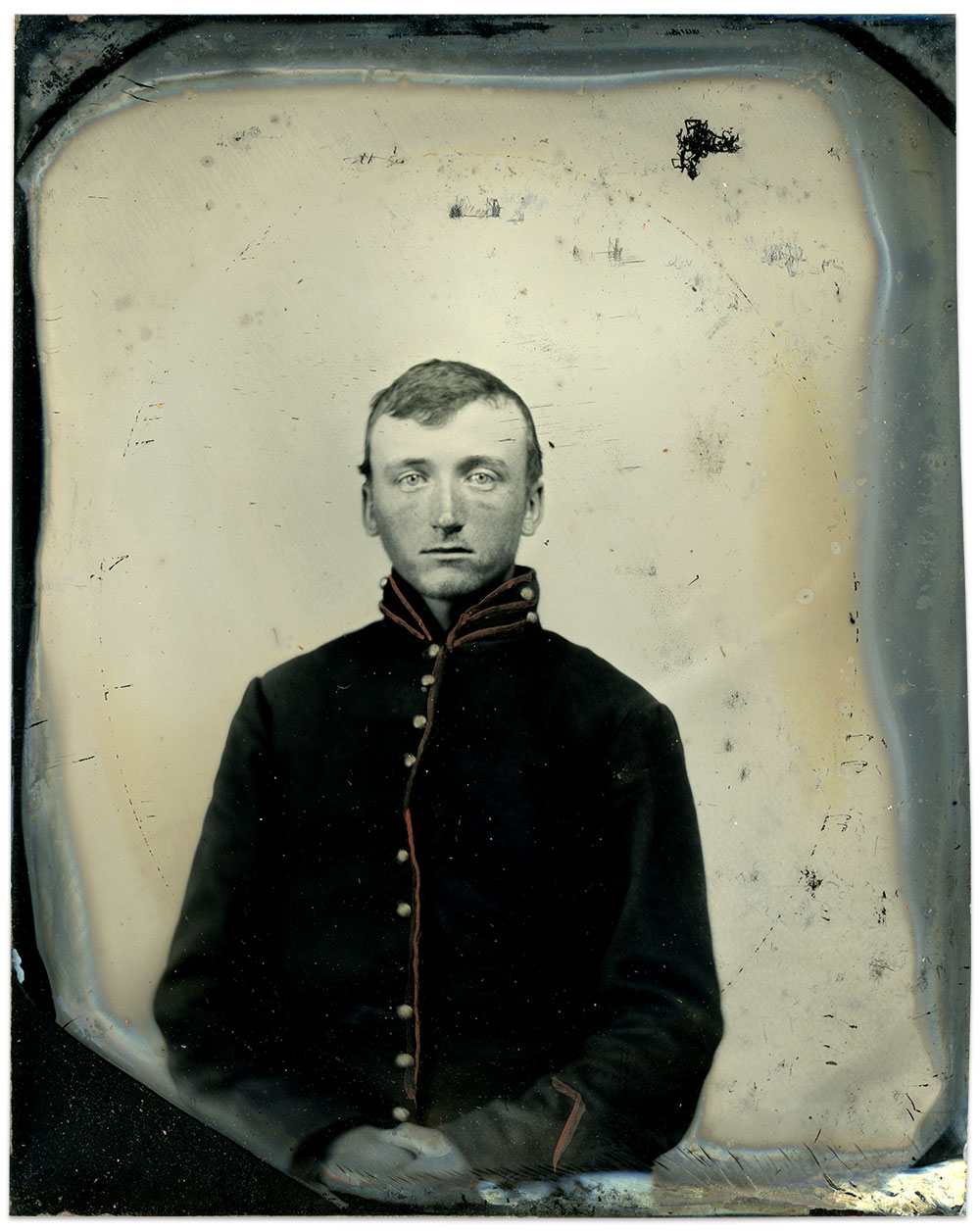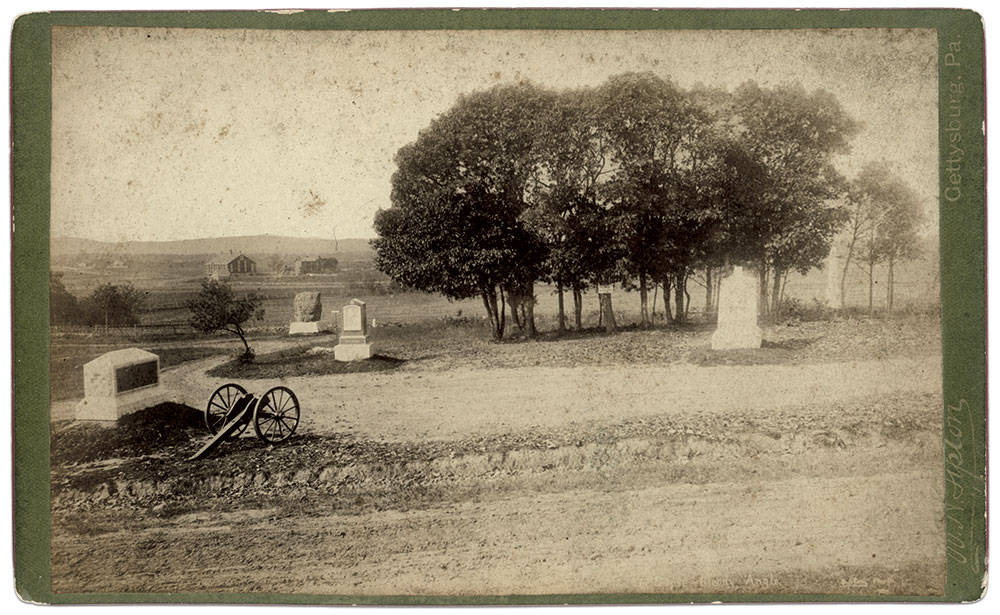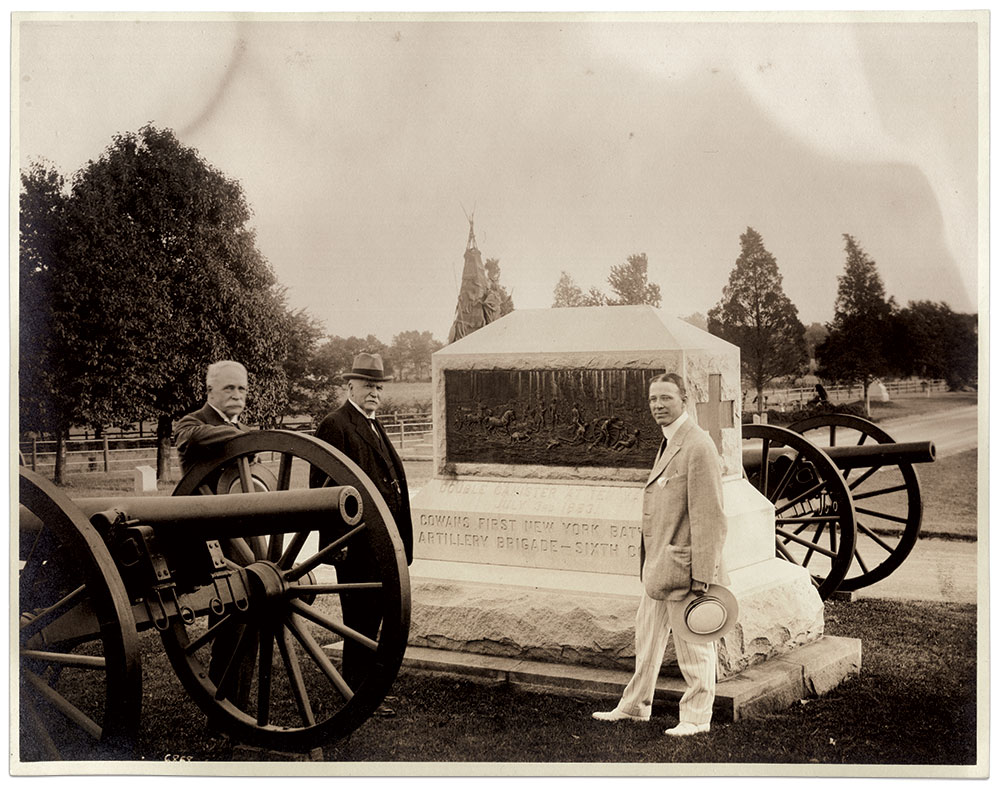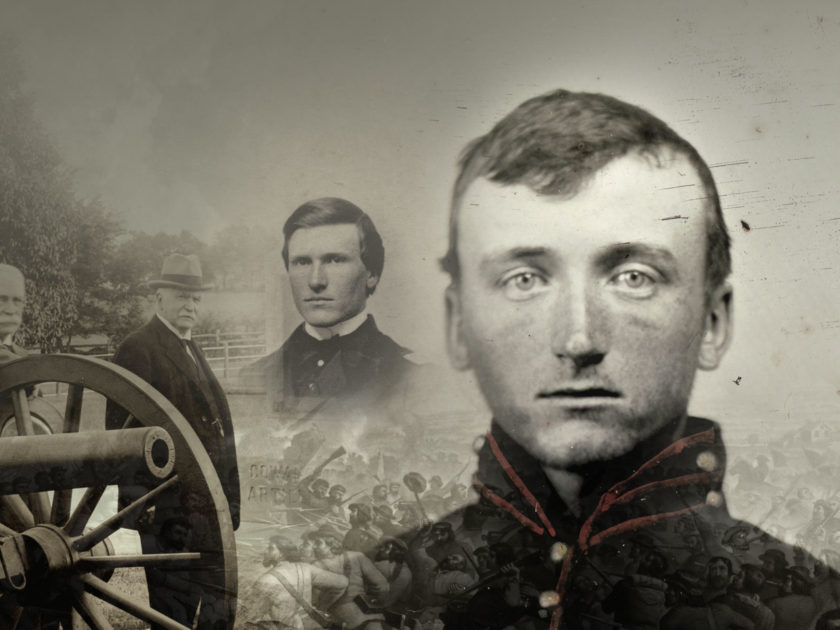By Charles Joyce
On the humid afternoon of July 3, 1863, a Union battery left its caissons behind and rumbled forward under a brisk rebel artillery fire. The fast-moving gunners from the 1st New York Independent Battery pulled up at the far left end of the long blue line on Cemetery Ridge. There, they began to unlimber a half-dozen 3-inch ordnance rifles.
As the work began under the scorching sun, gunner Otis Billings approached his commander, Capt. Andrew Cowan, and pleaded, ”Captain, I am very sick today. Please let me go back to the caissons.”
Recalling the incident nearly 50 years later in the pages of the Washington Post, Cowan recollected that Billings “looked as pale as a ghost” as he requested to go to the rear. Cowan knew him brave on other fields, and doubtless harbored some belief that Billings was indeed ill. Nevertheless, he answered in a sharp tone, “No Billings, this is no time to be sick” and ordered him to remain with his cannon.

Billings, a 22-year-old, unmarried schoolteacher and the eldest of 10 brothers and sisters, had left his family behind in September 1861 to enlist in the army. He first served with Battery E of the 1st New York Light Artillery, and distinguished himself during the Peninsula Campaign. His battery commander remembered that, at Yorktown in the spring of 1862, Billings volunteered to crawl through the no man’s land between the lines and dismantle a barricade of brush and rails that Confederate sharpshooters had used to snipe at his comrades.
A few months later, he transferred to Cowan’s Independents, and saw action at the battles of Antietam, Fredericksburg and Chancellorsville.
At Gettysburg, Billings’ fortitude seemed to falter. The oppressive heat, a lack of sleep—no one in his outfit had a decent sleep over the previous two nights—or the fear of what the day’s action might bring, may have prompted the momentary lapse. Whatever the reason, it did not matter. He obeyed his superior’s command and continued to unlimber the guns, along which, at any other time, would have been considered an insignificant Pennsylvania ridgeline.
The journey to that ridge had begun two days earlier, when the New Yorkers encamped near Manchester, Md., after several days of hard marching.
On July 1, a private in the battery, George Brockway, recorded in his diary that reveille sounded “as early as ever.” But, he added, no orders to move came, and “we lay in camp and enjoy the treat.” Not everyone passed the respite so pleasantly. Capt. Cowan, a strict disciplinarian, had Pvt. Henry Fisher tied to the spare wheel of Brockway’s caisson for breaking branches off of a local farmer’s cherry trees. No one had an inkling of the struggle going on more than 25 miles to the northwest. Cowan and his three lieutenants had cheerfully accepted an invitation to a banquet in town that evening. But as they stood in line at the food table, a winded courier arrived with orders to march. Cowan offered his regrets, and departed with a bottle of wine, given to him by the host. The battery, including Billings and his fellow gunners, was on the move by 9 p.m. They travelled all night, slowed by troops and trains on the road ahead.
Just after sunrise on July 2, the artillerists passed the town of Union Mills on the Baltimore Pike. Now, for the first time, the distant roar of cannon became audible. The march became a race for the front.
The battery arrived at Rock Creek by 2 p.m., and moved into a field, where Cowan ordered his men to remain on alert through the night. Cowan’s order was partly a reaction to a rumor that the Army of the Potomac had retreated, and that the battery and the rest of the Sixth Corps would act as the rear guard. Cowan remembered in the Post article, “the anxious, weary night, our second without rest, wore slowly away.” Tensions mounted for Billings and everyone else in the battery, for a retreat that never materialized.

Early the next day, Cowan received instructions to report to the First Corps for orders. He parked his battery by a grove of trees near headquarters and saw Maj. Gen. Abner Doubleday, who told Cowan to let his men get breakfast while he explained the situation. Cowan and his bugler rode their horses up a gentle rise to the top of Cemetery Ridge with Doubleday, who walked beside them. There, they spied Confederates across the plain near the Peach Orchard, moving around a battery of brass guns that glistened in the morning sun. Doubleday did not want the battery posted just yet as all was quiet, and he feared the presence of Union artillery on that part of the ridge might draw enemy fire.
Doubleday instructed Cowan to return to his men, and cautioned, “when I can use you I will send for you.” As the general took his leave, Cowan gauged the distance between the lines for later use. He and his bugler then cantered slowly down the line to the south, stopping near what he later described as “a bunch of small scrub oaks,” where three other batteries had clustered, before turning back to his waiting guns.
History would remember the site as “The Copse of Trees.”
“Everything was quiet as a church,” Cowan told the Post. He found his lieutenants sleeping in the shade and his men making coffee. Billings was somewhere in the mix, perhaps enjoying a tin cupful of coffee or maybe catching some shuteye.
Cowan passed the reins of his horse to the bugler, unbuckled his overcoat from his saddle, and spread it over the ground, preparing to get some rest. Just then, a shell screamed over their heads, followed by another. The woods seemed prepared to topple around them. The men scattered, and then returned to their guns after Cowan had his bugler sound, “Stand to Horse” and “Cannoneers to your Posts!”

Cowan reported that they promptly obeyed the command. “They were veterans,” he noted with pride. An aide to Doubleday appeared and directed the battery back up the hill. At this moment, Billings made his unsuccessful bid to stay out of the coming action.
More comically but in the same vein another gunner, an Irishman named John Smith, grabbed Cowan’s stirrup, and, after flashing a queer grin, said, “Captain, if you have no objection, I’ll lose a day.” Cowan did not find the comment worthy of a reply.
Cowan’s guns stood several hundred yards to the left of another Empire State battery commanded by Capt. James Rorty, and Battery B of the 1st Rhode Island Artillery. Beyond these guns sat The Copse, and on its opposite side, Lt. Alonzo Cushing’s 4th U.S. Artillery.
Cowan’s Battery opened up at once upon the Confederate cannon. Although the men had trained to fire slowly for accuracy, the supply of shell and shrapnel ran dangerously low after an hour. As Cowan ordered the caissons up from the rear, a staff officer rode in front of the battery at furious speed and shouted, “Cease firing. Hold your fire for the infantry.”
A thick blanket of smoke had settled across the field. Cowan’s crew could see nothing before them. The rebel cannon fire, which had mangled more than one gunner, continued unabated. Cowan was puzzled by a command to resume his return fire, when another aide rode past and yelled for him to report to Maj. Gen. Alexander Webb. Cowan hesitated. He’d been ordered to support the First Corps, and Webb, he knew, was a brigade commander in the Second Corps. Cowan looked to his right at The Copse and saw a general wildly waving his hat at him. It was Webb. Cowan recalled that he “at once determined to risk disobeying orders, as I must be needed there.” He ordered, “Limber to the right!”
“Our Battery has passed through a baptism of blood. We occupied the hottest place, in the center, and our loss was awful.” —Henry D. Vaughn
By this time, Billings and his comrades were either stripped to the shirt or bare-chested from a hot cannonade. They jumped upon the limbers or scurried beside them, as they cantered wildly ahead. Just before reaching the trees, Cowan yelled, “Left into battery,” and the guns moved to a spot on the left of The Copse, recently held by the Rhode Islanders that had retired after taking a pounding from the Confederate cannonade. As Cowan took this new position, the smoke rose from the field, and he remembered seeing “at a glance beyond the Emmitsburg Road what was meant by ‘holding my fire for the infantry.’ Longstreet was coming.”
Cowan called out the distances that he had committed to memory during his earlier reconnaissance. George Brockway helped cut fuses to the desired length at the nearby limber. Although shaken by a shell fragment that smashed a feedbag barely a foot from his head, he stayed at his post. The enemy infantry, Cowan remembered, “came on in splendid order, closing on their left as the shot and shell plowed gaps through their ranks. It was a wonderful sight.” The captain’s view of the spectacle was unhindered by anything other than the Codori House and barn, which hid the attackers momentarily from his sight. “When I saw them again,” he recalled, “they were coming at a run, without regard to alignment.”
Less than 200 yards away, Cowan called for Billings and his gunners to switch to canister, which tore large gaps in the rebel ranks. Undeterred, the Confederates closed with the Union line. A group of Confederates took refuge behind a slight rise of ground covered with brush and felled saplings. From here, they began to pick off the New Yorkers. Four men were hit, including Lt. William H. Johnson, shot in the upper thigh and carried to the rear with a wound that lamed him for life.
Billings and the others that remained depressed the muzzles of their guns as low as possible. Cowan ordered the men to pause and load double canister—“two hundred and twenty chunks of lead” as he described it, in each piece—and waited as the gray infantry closed.
Around him, the battery’s support began to crumble. Some of the infantry covering his guns moved through the trees to the right, with the rest breaking in panic for the rear. Cowan and his men swore and punched at the fleeing troops. One artilleryman even broke the bottom of a tin coffee pot over the head of an escaping soldier.
At the same time, the rebels rose from the rise and seized the opportunity to capture Cowan’s unprotected artillery. A young Confederate officer lifted his sword and screamed, “Take the guns!” He led his men forward, firing as they ran. More New Yorkers took hits. Pvt. Jacob McElroy fell dead before one piece with three rifle balls in his face. Lt. William Wright went down with a bullet in the chest. Cowan waited until the attackers were 10 yards away and then yelled, “fire!” Two-fisted loads of iron barked from the mouths of five field pieces.
The Confederate attack—Pickett’s Charge—was over.
Cowan later wrote to historian John Bachelder, “What was the result we did not halt to see.” Instead, he ordered the smoking guns dragged quickly behind the crest of the ridge where the limber chests waited with fresh ammunition, and reloaded with percussion shells. By this time, “Webb gallantly rallied his men, and the strength of the enemy was so nearly spent that the victory was ours.” Bareheaded, in his shirtsleeves, and covered with the black grime and sweat, Cowan was collared by New York Times correspondent Samuel Wilkeson. In his subsequent dispatch, published on July 6, Wilkeson noted that the battery’s “service of grape and canister was awful. It enabled our line, outnumbered two to one, first to beat back LONGSTREET, and the then to charge upon him, and take a great number of his men … prisoners.”

Union artillerist Charles Wainwright, surveying this ground the next day —The Fourth of July—wrote in his diary, “The enemy really lay in heaps; far more so at least than the dead often do on a battlefield, for historians draw largely on imagination when they talk of heaps of slain, and rivers of blood. There was about an acre or so of ground where you could not walk without stepping over there bodies, and I saw perhaps a dozen cases where they were heaped one on top of the other.”
Two members of Berdan’s sharpshooters ventured across the field and recognized the result of the double-shot canister directly in front of Cowan’s guns. The rebels lay very nearly in piles, most mangled and mutilated.
Another New Englander traversing the same ground wrote, “The dead are frightfully smashed, which is not be wondered at when we consider how they crowded up onto our guns, a mass of humanity, only to be hurled back an undistinguishable pile of flesh, rolling and writhing in death. No tongue can depict the carnage, and I cannot make it seem real; men’s heads are blown off or split open; horrible gashes cut; some split from the top of the head to the extremities, as butchers split beef.”
The carnage was not confined to the Confederate side of the stone wall. Battery commanders Cushing and Rorty were both killed, and their batteries wrecked. Cowan emerged unhurt. His guns were the only ones that remained in action, albeit with heavy losses. George Brockway scrawled in his diary, “They dealt a harsh hand to us, killing four and wounding several others.”
One sergeant, Henry D. Vaughn wrote to his mother, “Our Battery has passed through a baptism of blood. We occupied the hottest place, in the center, and our loss was awful.”
“He was killed, bravely serving his gun.”
Among the dead was Otis Billings, shot in the head during the final struggle. “Poor boy,” lamented the man who had made him stay and fight. “He was killed, bravely serving his gun.”
Wilkeson’s report prominently listed Billings among the dead of the battle. The unassuming bachelor teacher from upstate New York, who had not wanted to fight that day, achieved grim immortality on the front page of the Times. It is possible that this was how the Billings family learned of his fate.
Cowan had Billings buried on the battlefield, alongside the other fatalities of the battery. He found the rebel officer who had tried to take his gun, and ordered that he too be buried alongside these men. Boards from cracker boxes marked the graves.
The Billings family retrieved the body of their son and brother for re-interment in New York. His remains rest in Highland Cemetery in the town of Avoca in Steuben County.
The author wishes to thank the generosity of Mark Warren, who shared the diary of George Brockway and images of Cowan’s men from his collection.
References: New York Times, July 6, 1863; Washington Post, July 2, 1911; National Tribune, Nov. 12. 1903; New York at Gettysburg, Vol. III; Murray, “Hurrah for the Ould Flag!”: The True Story of Captain Cowan and the First New York Independent Battery at Gettysburg; Murray, “My Devoted Cannoneers and Drivers Stood Their Ground:” Cowan’s, Cushing’s, and Rorty’s Batteries in Action During the Pickett-Pettigrew-Trimble Charge, Gettysburg Magazine 39 (2006); Busey and Busey, Union Casualties at Gettysburg: A Comprehensive Record, Vol. 2; Coco, A Strange and Blighted Land, Gettysburg: The Aftermath of a Battle; Nevins, Ed., A Diary of Battle: The Personal Journals of Colonel Charles S. Wainwright, 1861-1865.
Charles Joyce, of Media, Pa., has been a lifelong student of the Civil War and started collecting images about 25 years ago. He currently focuses on photographs of soldiers killed, wounded or captured at the Battle of Gettysburg, and on original stereoviews taken of the battlefield.
SPREAD THE WORD: We encourage you to share this story on social media and elsewhere to educate and raise awareness. If you wish to use any image on this page for another purpose, please request permission.
LEARN MORE about Military Images, America’s only magazine dedicated to showcasing, interpreting and preserving Civil War portrait photography.
VISIT OUR STORE to subscribe, renew a subscription, and more.

